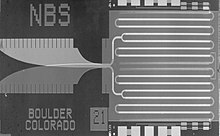Volt

The volt (symbol: V) is the SI derived unit for electric potential, electric potential difference, and electromotive force.[1] The volt is named in honor of the Italian physicist Alessandro Volta (1745–1827), who invented the voltaic pile, possibly the first chemical battery.
Definition
A single volt is defined as the difference in electric potential across a wire when an electric current of one ampere dissipates one watt of power.[2] It is also equal to the potential difference between two parallel, infinite planes spaced 1 meter apart that create an electric field of 1 newton per coulomb. Additionally, it is the potential difference between two points that will impart one joule of energy per coulomb of charge that passes through it. It can be expressed in terms of SI units as follows:
It can also be written using only the SI base units m, kg, s, and A as:
Josephson junction definition
Between 1990 and 1997, the volt was calibrated using the Josephson effect for exact voltage-to-frequency conversion, combined with cesium-133 time reference, as decided by the 18th General Conference on Weights and Measures. The following value for the Josephson constant is used:
This is typically used with an array of several thousand or tens of thousands of junctions, excited by microwave signals between 10 and 80 GHz (depending on the array design).[3] Empirically, several experiments have shown that the method is independent of device design, material, measurement setup, etc., and no correction terms are required in a practical implementation.[4] However, as of July 2007, this is not the official BIPM definition of Volt.[5]
Water flow analogy
In the water flow analogy sometimes used to explain electric circuits by comparing them to water-filled pipes, voltage difference is likened to water pressure difference.
The relationship between voltage and current (in ohmic devices) is defined by Ohm's Law.
Common voltages


Nominal voltages of familiar sources:
- Nerve cell resting potential: around −75 mV[6]
- Single-cell, rechargeable NiMH or NiCd battery: 1.2 V
- Mercury battery: 1.355 V
- Single-cell, non-rechargeable alkaline battery (e.g., AAA, AA, C and D cells): 1.5 V
- LiFePO4 rechargeable battery: 3.3 V
- Lithium polymer rechargeable battery: 3.75 V (see Rechargeable battery#Table of rechargeable battery technologies)
- Transistor-transistor logic/CMOS (TTL) power supply: 5 V
- PP3 battery: 9 V
- Automobile electrical system: nominal 12 V, about 11.8 V discharged, 12.8 V charged, and 13.8–14.4 V while charging (vehicle running).
- Household mains electricity: 230 V RMS in Europe, Asia and Africa, 120 V RMS in North America, 100 V RMS in Japan (see List of countries with mains power plugs, voltages and frequencies)
- Trucks/lorries: 24 V DC
- Rapid transit third rail: 600–750 V (see List of current systems for electric rail traction)
- High-speed train overhead power lines: 25 kV RMS at 50 Hz, but see the list of current systems for electric rail traction and 25 kV at 60 Hz for exceptions.
- High-voltage electric power transmission lines: 110 kV RMS and up (1.15 MV RMS was the record as of 2005[citation needed])
- Lightning: Varies greatly, often around 100 MV.
Note: Where RMS (root mean square) is stated above, the peak voltage is times greater than the RMS voltage for a sinusoidal signal centered around zero voltage.
History of the volt

In 1800, as the result of a professional disagreement over the galvanic response advocated by Luigi Galvani, Alessandro Volta developed the so-called Voltaic pile, a forerunner of the battery, which produced a steady electric current. Volta had determined that the most effective pair of dissimilar metals to produce electricity is zinc and silver. In the 1880s, the International Electrical Congress, now the International Electrotechnical Commission (IEC), approved the volt as the unit for electromotive force. At that time, the volt was defined as the potential difference [i.e., what is nowadays called the "voltage (difference)"] across a conductor when a current of one ampere dissipates one watt of power.
The international volt was defined in 1893 as 1/1.434 of the emf of a Clark cell. This definition was abandoned in 1908 in favor of a definition based on the international ohm and international ampere until the entire set of "reproducible units" was abandoned in 1948.
Prior to the development of the Josephson junction voltage standard, the volt was maintained in national laboratories using specially constructed batteries called standard cells. The United States used a design called the Weston cell from 1905 to 1972.
The volt is named after Alessandro Volta. As with every SI unit named for a person, its symbol starts with an upper case letter (V), but when written in full, it follows the rules for capitalisation of a common noun; i.e., volt becomes capitalised at the beginning of a sentence and in titles but is otherwise in lower case.
See also
- Ohm
- Orders of magnitude (voltage)
- SI electromagnetism units
- SI prefix for unit prefixes
References
- ^ "SI Brochure, Table 3 (Section 2.2.2)". BIPM. 2006. Retrieved 2007-07-29.
- ^ BIPM SI Brochure: Appendix 1, p. 144
- ^ Burroughs, Charles J.; Benz, Samuel P.; Hamilton, Clark A. (1999-06-01), "1 Volt DC Programmable Josephson Voltage Standard", IEEE transactions on applied superconductivity, 9 (3): 4145–4149, ISSN 1051-8223
{{citation}}:|first3=missing|last3=(help) - ^ Keller, Mark W (2008-01-18), "Current status of the quantum metrology triangle" (PDF), Metrologia, 45 (1): 102–109, Bibcode:2008Metro..45..102K, doi:10.1088/0026-1394/45/1/014, ISSN 0026-1394,
Theoretically, there are no current predictions for any correction terms. Empirically, several experiments have shown that KJ and RK are independent of device design, material, measurement setup, etc. This demonstration of universality is consistent with the exactness of the relations, but does not prove it outright.
{{citation}}: Unknown parameter|month=ignored (help) - ^ http://www.bipm.org/en/si/si_brochure/chapter2/2-1/
- ^ Bullock, Orkand, and Grinnell, pp. 150–151; Junge, pp. 89–90; Schmidt-Nielsen, p. 484



